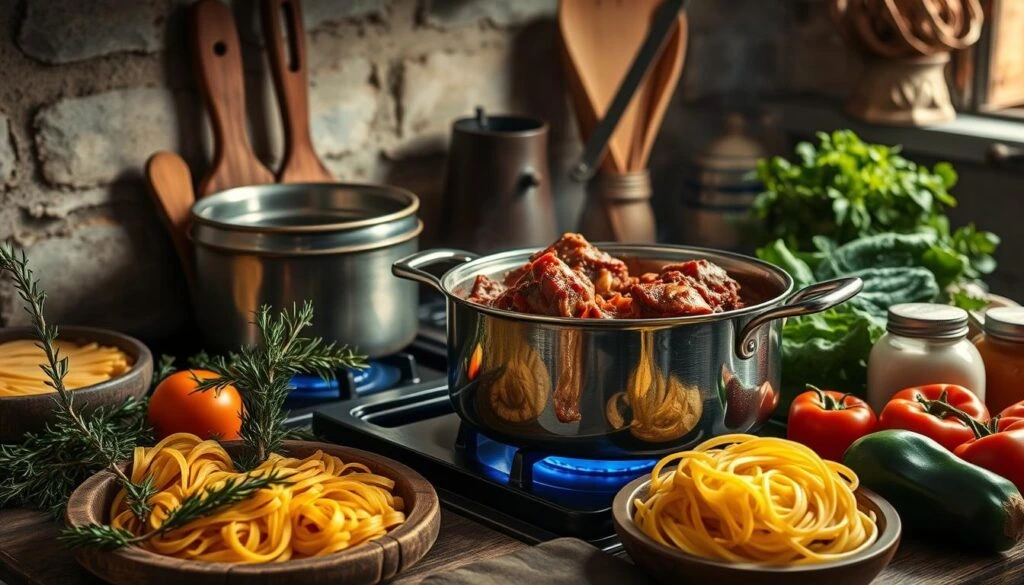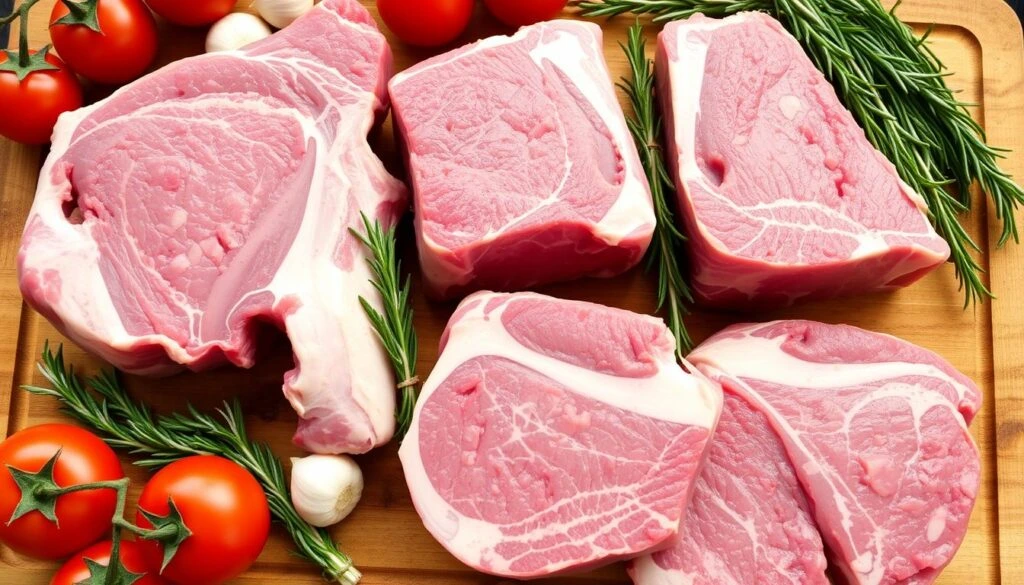Start a delicious journey through Italy’s Abruzzo region with this lamb ragù recipe. It’s slow-cooked with rosemary, showing off the area’s rich food traditions. This dish is a must-try for anyone who loves good food.
Table of Contents
Key Takeaways
- Discover the origins and significance of the lamb ragù d’Abruzzo, a signature dish of the Abruzzo region.
- Understand the essential ingredients, including the perfect cut of lamb, fresh herbs, and aromatic wine and stock, that lend depth and complexity to this dish.
- Explore the traditional cooking methods and equipment used to achieve the authentic flavors and textures of this slow-cooked masterpiece.
- Learn how to perfectly pair this lamb ragù with the ideal wine, as well as serving suggestions to elevate your dining experience.
- Uncover tips and techniques for replicating the unique Abruzzo flavors, from regional spice combinations to temperature control methods.
Introduction to Abruzzo’s Signature Lamb Dish
Abruzzo, a beautiful region in central Italy, is famous for its delicious food traditions. At the center of these traditions is a dish that’s loved everywhere: the tasty lamb ragù d’Abruzzo.
The history of Abruzzo is tied to lamb, thanks to the region’s shepherds. They have lived in the mountains for generations. The slow-cooked lamb ragù shows the region’s strength and the creativity of its cooks.
This dish is more than just food; it’s a symbol of Italian regional cuisine’s variety. The lamb ragù d’Abruzzo uses special herbs and spices that are unique to Abruzzo.
Next, we’ll explore the dish’s history, ingredients, and how to make it. You’ll learn how to choose the right lamb and make the sauce. This guide will help you make the real flavors of lamb ragù d’Abruzzo at home.
Essential Ingredients for Lamb Ragù d’Abruzzo Rose Mary Recipe
To make a true lamb ragù d’Abruzzo, picking the right ingredients is key. You need the best lamb, Italian herbs, cooking wine, and meat stock. Each one is important for the dish’s unique taste.
Selecting the Perfect Cut of Lamb
The best lamb cuts for a rich ragù are shoulder or leg. They offer the right mix of tenderness and flavor. Choose bone-in cuts for more flavor from the marrow.

Fresh Herbs and Aromatics
Lamb ragù d’Abruzzo needs rosemary, a key herb from Abruzzo. Add thyme, oregano, and bay leaves for a perfect mix of scents.
Wine and Stock Selection
The right cooking wine and meat stock are crucial. Use a dry, full-bodied red wine from Abruzzo. A Montepulciano or Sangiovese works well. Pair it with a rich meat stock for a true taste.
Traditional Cooking Methods and Equipment
Preparing the authentic lamb ragù d’Abruzzo Rose Mary requires traditional methods and special equipment. These elements are key to getting the rich flavors that make this Italian dish so loved. Let’s look at the traditional methods and tools used in Abruzzese kitchens.
Slow cooking is key for this recipe because it allows the lamb to break down slowly. This releases its juices and develops a rich flavor. The best way to do this is to simmer the ragù on low heat for several hours. This is often done in a heavy-bottomed Italian cookware like a Dutch oven or a traditional cooking pot made of terra cotta or cast iron.
Aromatics like onions, carrots, celery, and fresh herbs are slowly cooked in olive oil. This creates a flavorful soffritto base. Slow cooking makes vegetables taste sweeter and richer. It also adds pleasant aromas to the dish.
- Use a traditional cooking pot or Dutch oven for slow cooking the ragù
- Sauté the soffritto ingredients over low heat to develop their flavors
- Add the perfect mix of fresh herbs, like rosemary, thyme, and bay leaves
- Let the ragù simmer for several hours, stirring now and then, to get the right texture and flavor
By using these old traditional cooking techniques and the right Italian cookware, you can bring out the true taste of Abruzzo’s lamb dish. It will take you straight to the heart of this enchanting region.

Step-by-Step Preparation Guide
Making the perfect lamb ragù d’Abruzzo Rose Mary recipe needs careful steps. From meat preparation to slow-cooking, each step is important. This dish is a regional specialty that is rich in flavor.
Meat Preparation Techniques
Start by picking a high-quality lamb cut, like the shoulder or leg. Remove any extra fat and cut the meat into small pieces. This makes the meat preparation easier and helps with even cooking. Sprinkle salt and pepper on the lamb to improve its taste.
Creating the Soffritto Base
The essence of this dish lies in the soffritto foundation. In a sizable pot or Dutch oven, warm some olive oil. Incorporate diced onions, carrots, and celery, and sauté them. Cook them until they achieve a caramelized texture, which enhances their sweetness and infuses the soffritto base with flavor.
Slow-Cooking Process
Incorporate the lamb into the soffritto base and sear the meat to develop a crust. Then, add red wine to deglaze the pan, ensuring to scrape up the caramelized bits. Following that, mix in crushed tomatoes, stock, and fresh herbs such as rosemary, thyme, and bay leaves.
Cover the pot and allow it to gently simmer on low heat for 2 to 3 hours. This slow cooking process tenderizes the meat and harmonizes the flavors effectively.
Exercise patience during this cooking phase. The extended simmering transforms the ragù into an exceptional dish. Stir occasionally and incorporate more stock or water as needed to maintain the desired consistency.
Wine Pairing and Serving Suggestions
When it comes to Italian wine pairing for your lamb ragù, the choices are vast. A bold red wine is perfect to match the rich, meaty sauce. This will enhance the taste of the dish.
For a true taste of Abruzzo, try a Montepulciano d’Abruzzo. This robust red wine features notes of juicy plum, black cherry, and spice. It complements pasta dishes beautifully, especially when served with lamb ragù.
Looking to try something different? A Sangiovese or Nero d’Avola can also pair well. These wines offer a great balance of acidity and tannins. They cut through the richness of the dish nicely.
When serving lamb ragù, pair it with traditional pasta shapes. Pappardelle or rigatoni work great. Pappardelle’s flat shape lets the sauce cling well. Rigatoni’s ridges catch every delicious bite.
Top your lamb ragù with fresh parsley or extra virgin olive oil. This adds freshness and brightness. Serve it with a simple salad or crusty bread for a complete meal.
Tips for Achieving Authentic Abruzzo Flavors
To make a true Abruzzo lamb ragù, it’s more than just a recipe. You need to know about Abruzzo spices, the right cooking temperature, and the perfect ragù consistency. Here are some expert tips to help you get it just right.
Regional Spice Combinations
The flavor of Abruzzo’s lamb ragù comes from special spices. You’ll need garlic, onion, and Abruzzo spices like rosemary, thyme, and fennel seeds. Try different amounts to find the perfect mix that takes you to Abruzzo’s hills.
Temperature Control Methods
Getting the cooking temperature right is key for a smooth ragù. First, sear the lamb at high heat to keep the juices in. Then, lower the heat and let it simmer for hours. This slow cooking makes the ragù consistency perfect, with meat that’s easy to shred.
Texture Perfection Guide
- Finely chop the onions, garlic, and herbs for a good soffritto base.
- Brown the lamb in batches for a nice caramelized crust.
- Use red wine to deglaze the pan, getting all the tasty bits.
- Simmer the ragù gently, stirring now and then, until it’s tender and thick.
With these tips, you’ll be making a real Abruzzo-style lamb ragù. It will impress your taste buds and take you to the beauty of Abruzzo, Italy.
Storage and Reheating Guidelines
Keeping your lamb ragù d’Abruzzo rose mary fresh is key to enjoying it later. The right food storage and reheating methods help keep its taste and smell just right.
For storing leftovers, act fast. Put the ragù in airtight containers or bags to keep air out. Refrigerate it within 2 hours of cooking. It remains fresh for three to four days. Additionally, you can freeze it for two to three months.
Reheating Lamb Ragù d’Abruzzo Rose Mary
Ready to enjoy your reheating ragù? Just follow these easy steps:
- Thaw frozen ragù in the fridge overnight, if it’s frozen.
- Heat the ragù in a saucepan or skillet over medium heat. Add a bit of broth or water to keep it moist.
- Stir the ragù now and then until it’s hot and the flavors are back.
- Check the seasoning and adjust if needed. Serve hot for the best taste.
By storing and reheating your lamb ragù d’Abruzzo rose mary right, you can enjoy its rich flavors again. Your leftovers will taste just like the first time, bringing the true Abruzzo taste to your table.
Common Variations and Modern Adaptations
The beloved lamb ragù d’Abruzzo Rose Mary recipe is perfect for making changes. You can try ragù variations, ingredient substitutions, or dietary modifications. This classic Italian dish is a blank canvas for your creativity.
Contemporary Ingredient Substitutions
Want to try new flavors or fit dietary needs? The ragù recipe is easy to change. Here are some ideas:
- Use ground turkey or beef for a leaner option instead of lamb.
- Try a white wine or dry sherry instead of red wine for a different taste.
- Add roasted vegetables like eggplant or zucchini for a fresh twist.
Dietary Modifications
Make the ragù d’Abruzzo Rose Mary recipe fit your needs. Here are some tips:
- For gluten-free, use gluten-free pasta like zucchini noodles or quinoa.
- Make it dairy-free by skipping the Parmesan or using a plant-based alternative.
- If you are on a low-carb or ketogenic diet, use cauliflower rice or zucchini noodles instead of regular pasta or rice.
By experimenting with various ragù recipes, altering ingredients, and adjusting dietary components, you can personalize this classic dish. In doing so, it can accommodate the preferences and dietary requirements of everyone.
Conclusion
In this guide, you discovered the culinary traditions of Abruzzo and the process of preparing its famous lamb ragù. By using traditional methods and the right ingredients, you can make this Italian dish at home.
The lamb ragù d’Abruzzo with rosemary shows Abruzzo’s love for its land and cooking traditions. Choosing the right lamb and simmering the sauce slowly makes the dish rich and complex.
Enjoying the lamb ragù, we invite you to explore more of Abruzzo’s food. This region, between the Apennine Mountains and the Adriatic Sea, has many tasty dishes to try. Abruzzo’s food offers exciting flavors, whether you enjoy the bold tastes of the countryside or the fresh dishes from the sea. It can inspire your next cooking project.
FAQ
What is the origin of the lamb ragù d’Abruzzo rose mary recipe?
The lamb ragù d’Abruzzo rose mary recipe comes from Abruzzo, Italy. This region is known for its strong food traditions and its love for lamb.
What are the key ingredients in the traditional lamb ragù d’Abruzzo recipe?
The main ingredients are high-quality lamb, fresh rosemary, onions, garlic, good wine, and meat stock. These make the dish authentic.
How is the lamb ragù d’Abruzzo traditionally prepared?
It’s made by slow-cooking the lamb with rosemary, onions, garlic, wine, and stock. This method blends the flavors well.
What are some tips for achieving the authentic Abruzzese flavors in the lamb ragù?
Use local spices, control the heat, and aim for the right consistency. These steps help get the true Abruzzese taste.
How should the lamb ragù d’Abruzzo be served and paired?
Serve it with pasta like pappardelle or rigatoni. It goes well with full-bodied Italian red wines, enhancing the dish’s flavors.
Can the traditional lamb ragù d’Abruzzo recipe be modified or adapted?
Yes, you can change it to fit different diets or tastes. Just keep the core Abruzzese flavors in mind.
How should the lamb ragù d’Abruzzo be stored and reheated?
Store it in an airtight container. Keep it in the fridge or freezer. Reheat it gently to keep the flavors and texture intact.



